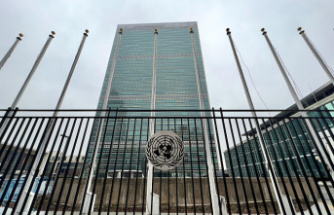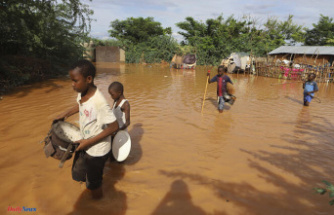Forty-two days lasted the most important volcanic eruption he had suffered the palm in the last century until on September 19 he had volcanic activity on the island again. In 1971, there was another eruption, that of the volcano has, which lasted 23 days but did not affect populations or crop.
What happened during the summer of 1949 can offer some clues about how it could be the evolution of the current eruption in the Old Summit Park, which in the 21 days it has been underway has already overcome the surface wasted during the episode that occurred 72 Years, known as the eruption of the Namboque volcano (through the area in which it originated) or San Juan began to roar at 11 o'clock on the morning of June 24, San Juan's Day. He stopped his activity suddenly but resumed her four days later and he no longer stopped until August 4.
So far, the Old Summit volcano has stopped emitting material for a few hours. It occurred on September 27 but that afternoon, resumed its activity in a more intense way. These unforeseen and unpredictable parons are usual, according to vulcanologists, and do not mean that the end of volcanic activity is close.
Last Thursday we saw as on his way to the sea, the lava reached the fajana or Delta Lavico that was created in 1949, between the beach of Los Guirres and the Charchon. A land that has been used during these decades to harvest bananas as volcanic soils are very fertile.
Both eruptions, the 1949 and 2021, have been classified as grade 2 according to the volcanic explosive index, which uses a scale of 0 to 8 (8 being of the greatest explosiveness), and also the two are cataloged as of Strombolian type with freatomagma episodes (by coming into contact with a water source). The current one is also having Hawainan episodes (with a more fluid lava).
On October 1, the Old Summit Volcano (which originated in the area known as Vaca Head) had already exceeded the amount of lava emitted during the two eruptions that had in La Palma the last century, although the instruments that are used Now they are more precise. According to the estimates of scientists, more than 80 million cubic meters of magmatic material, compared to the 55 million episode of 1949 and 43 million meters measured in 1971.
The Old Summit Volcano has also exceeded the surface wasted by lava in half days in eruption than that of San Juan. While in the eruption of San Juan expanded by an area of 450 hectares and in that of Teneguía by 213 hectares, last Friday the surface affected by the current eruption amounted to 471.8 hectares and this Sunday has reached the 500 hectares After razing the Industrial Polygon Road de la Gata.
As detailed on Friday at the press conference, the Technical Director of the Volcanic Emergency Plan of Canarias (pevolca), Miguel Ángel Morcuende, some 120 hectares correspond to agricultural holdings (59.3 hectares of Plannera, 33.4 of Vineyard and 7.36 of Avocado) and 26.4 kilometers on roads.
On the other hand, the fajana formed at sea by the current eruption surpasses 34 hectares, compared to the 80 hectares that the Volcano de San Juan won to the sea and the 29 hectares of land that Henuguan created.
In all these eruptions there were earthquakes during the previous days. "The data we have of ancient eruptions are only the earthquakes, which is a much more limited information because it could not be known at what depth the earthquake had occurred. But it is true that most of the eruptions in the Canary Islands have had Precursor seismicity, not only in those of La Palma, also in other islands. It is a fairly common phenomenon, "he explains from La Palma Francisco Javier Almendros, professor of the Department of Theoretical Physics and the Cosmos of the University of Granada.
As narrated in 1949 the Geographer Engineer Juan M. Bonelli Rubio in a delicious historical story collected by the Geographical and Catastral Institute (contribution to the study of the Rusting of the NAMBROQUE volcano or San Juan), the eruption of the volcano de San Juan was preceded as well For several seismic jerks, as it has occurred again this year because September 11 began seismic swarm in La Palma.
"Already prior to eruption, on June 21, two intense seismic shakers were felt, and on 22 and 23, immediately to the eruption, other frequent shaking of little intensity, but that they had sown restlessness as logically could be expected ", he wrote in 1949 Bononi Rubio, who was regretting himself not to dispose of the palm, as North Americans had in Hawaii, of a seismological observatory in the vicinity he would have been able to capture other premonitory seismic jerks from the eruption" that could have been able to Allow to assume or glimpse something from what was set inside the Isleña Earth and even perhaps predict the likely place of the future eruption. "
The engineer would have been amazed with the large number of instruments that allow today to monitor the volcano and study it, even if it remains impossible to determine when it will stop emitting washes.
In his story, he listed the well-known eruptions on the island from which he occurred in 1585 in Los Llanos. In 1646 the eruption of Tigalate took place, whose crater opened in the same region of the eruption of 1949, a couple of kilometers further south, on the call mountain of the kid. Shortly after, in 1667, the fuence eruption took place, the most important of the four historic ones that are recorded while 1712, the eruption of the puddle occurred. For more than two centuries, the palm remained calm.
Date Of Update: 15 October 2021, 15:27











